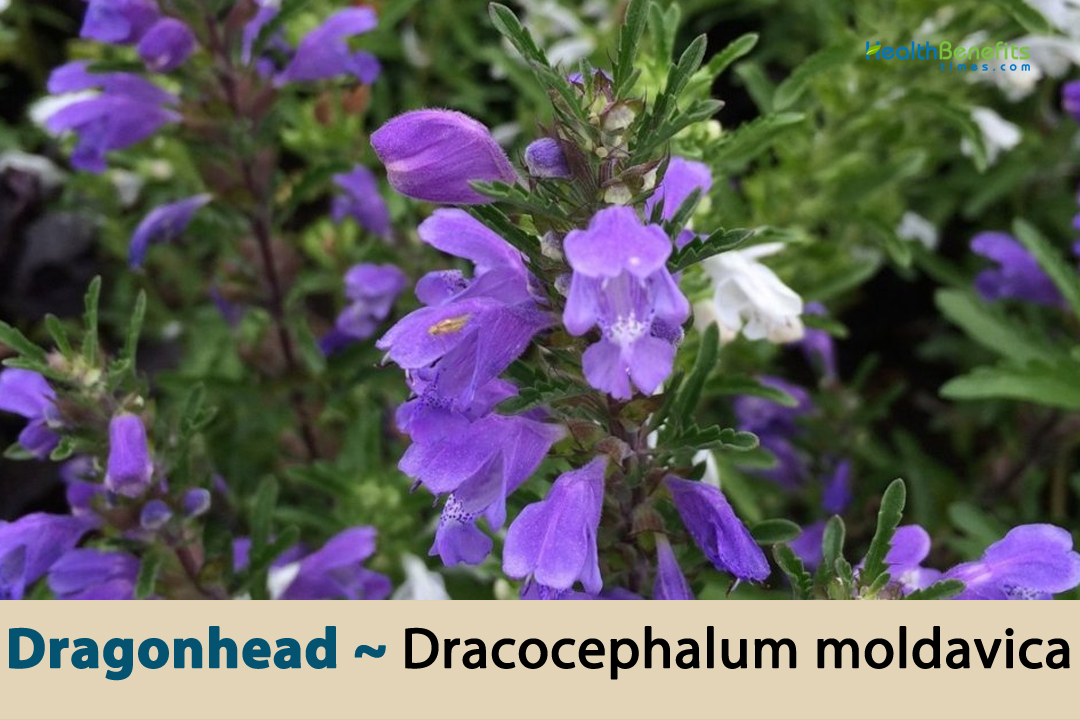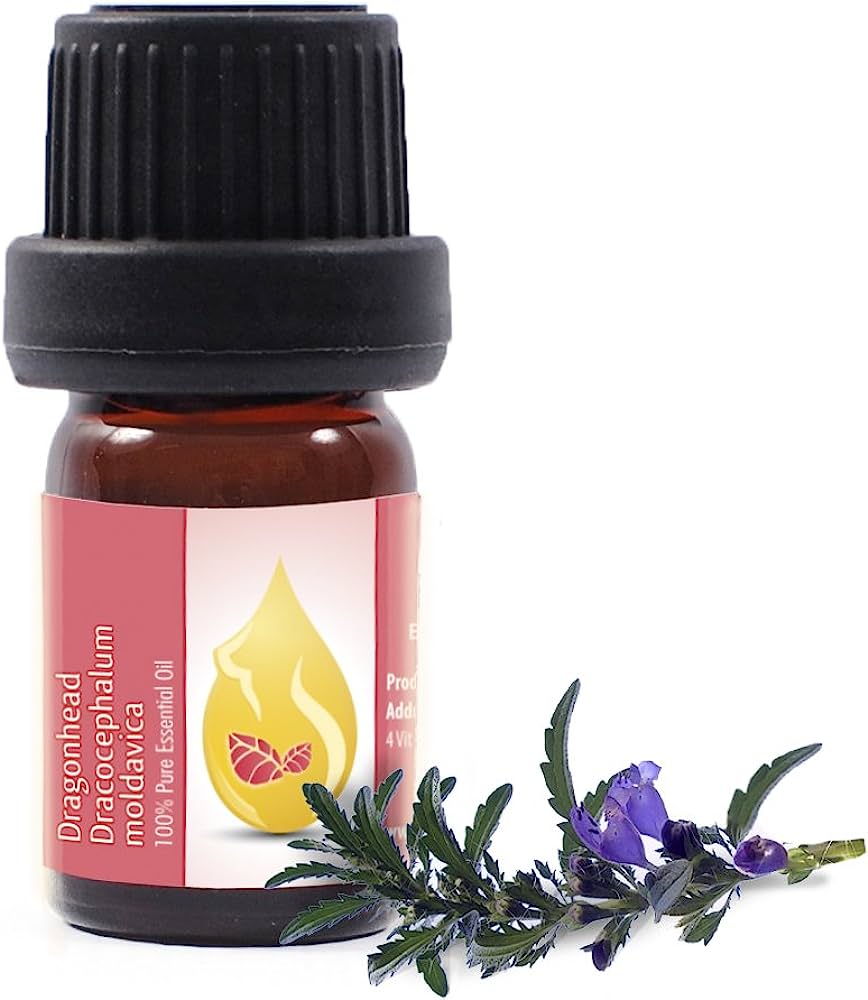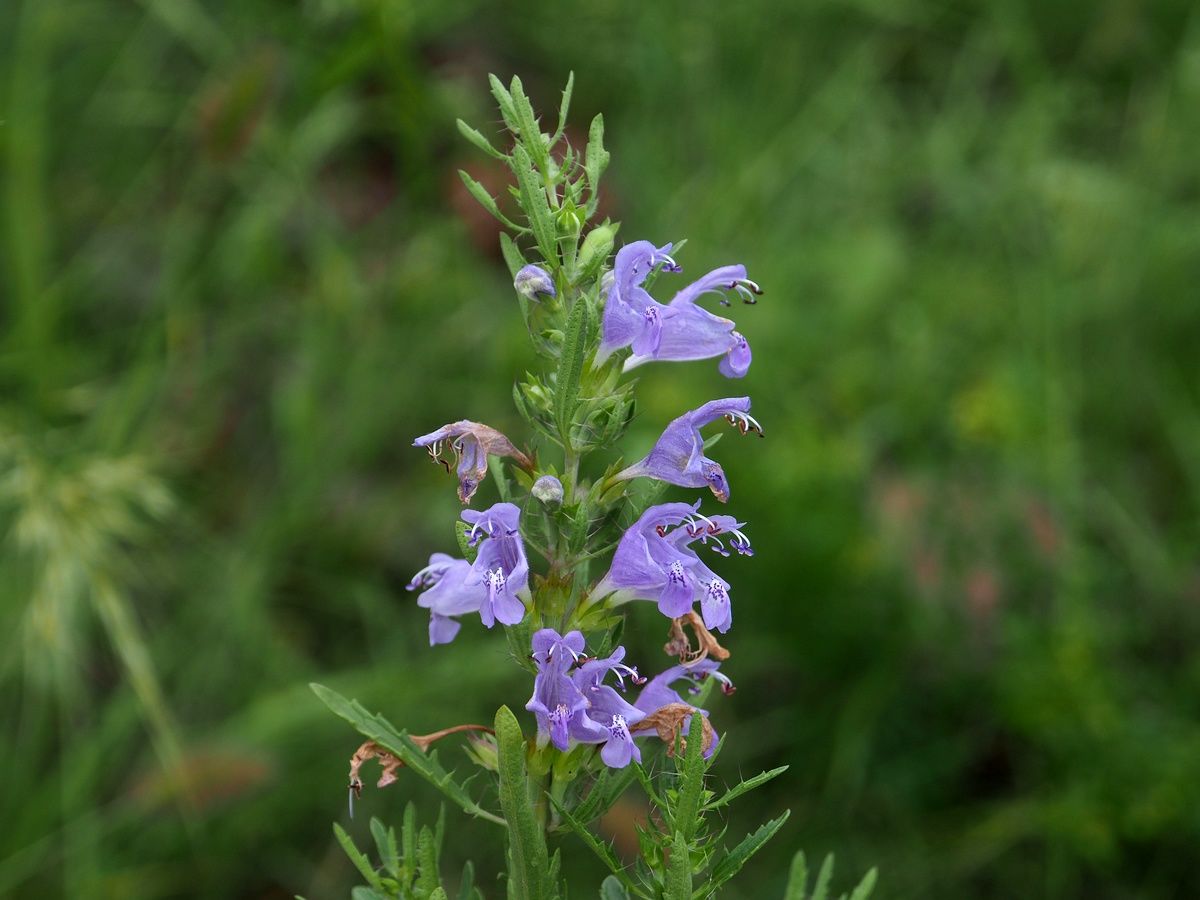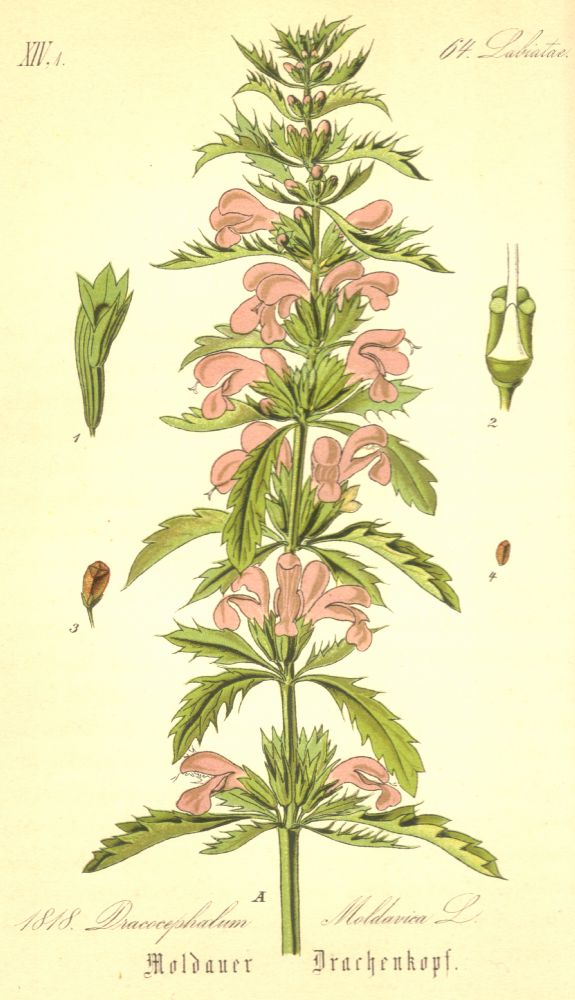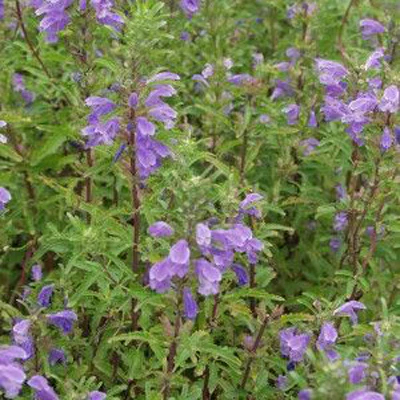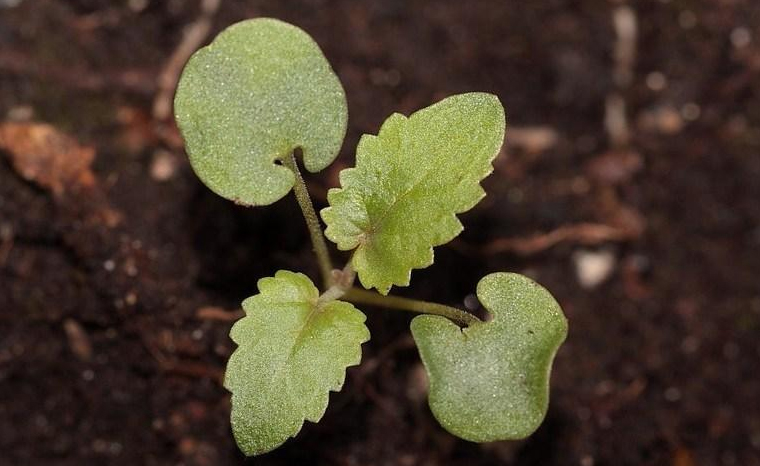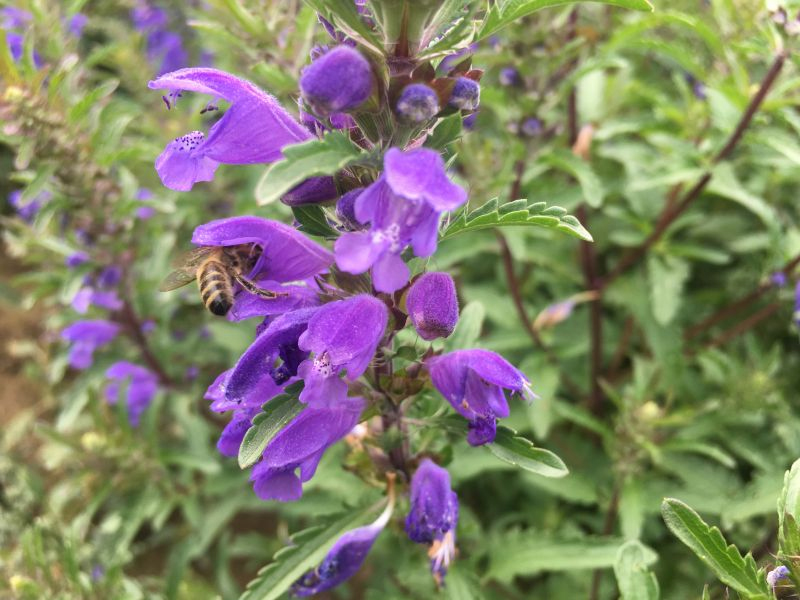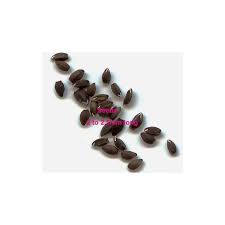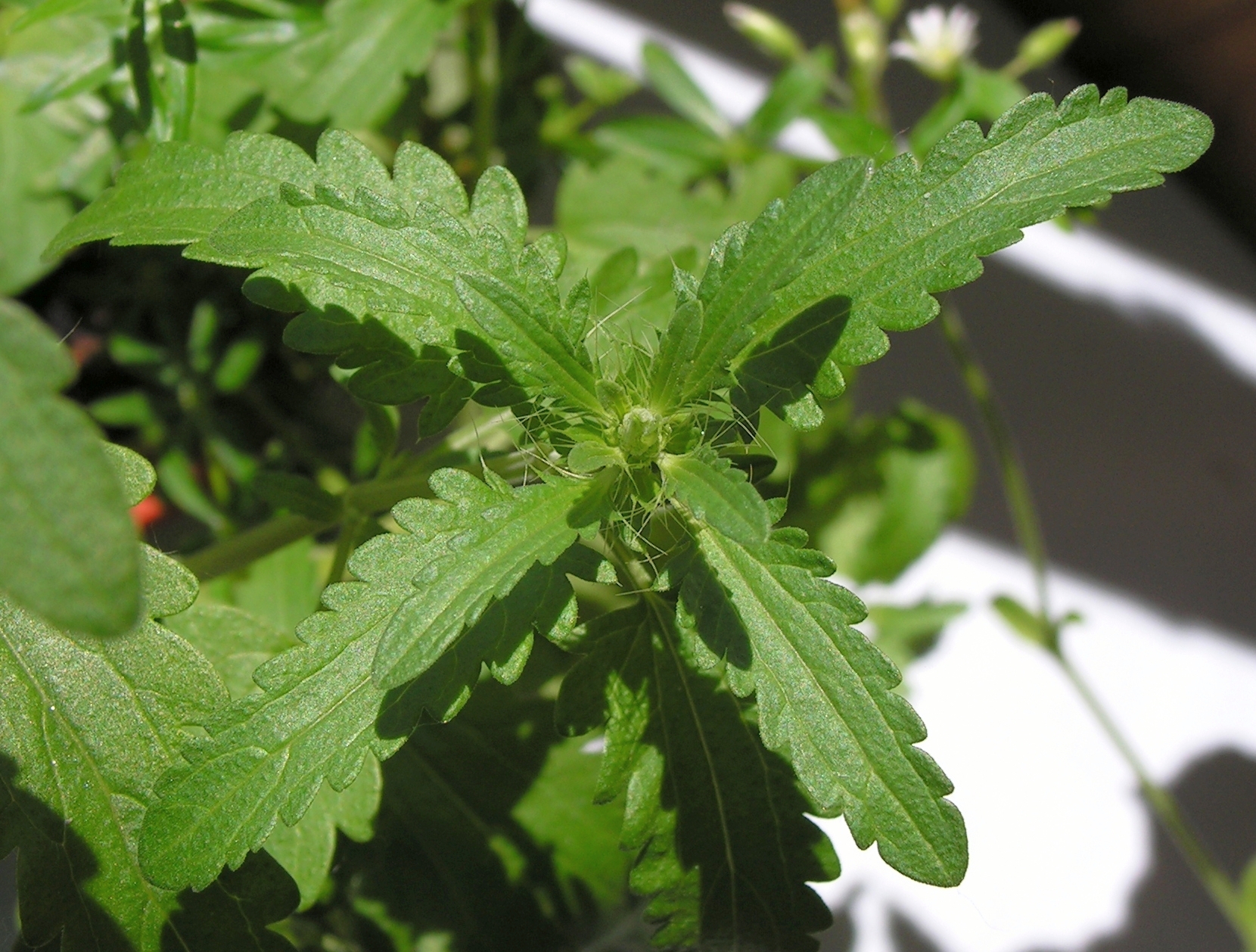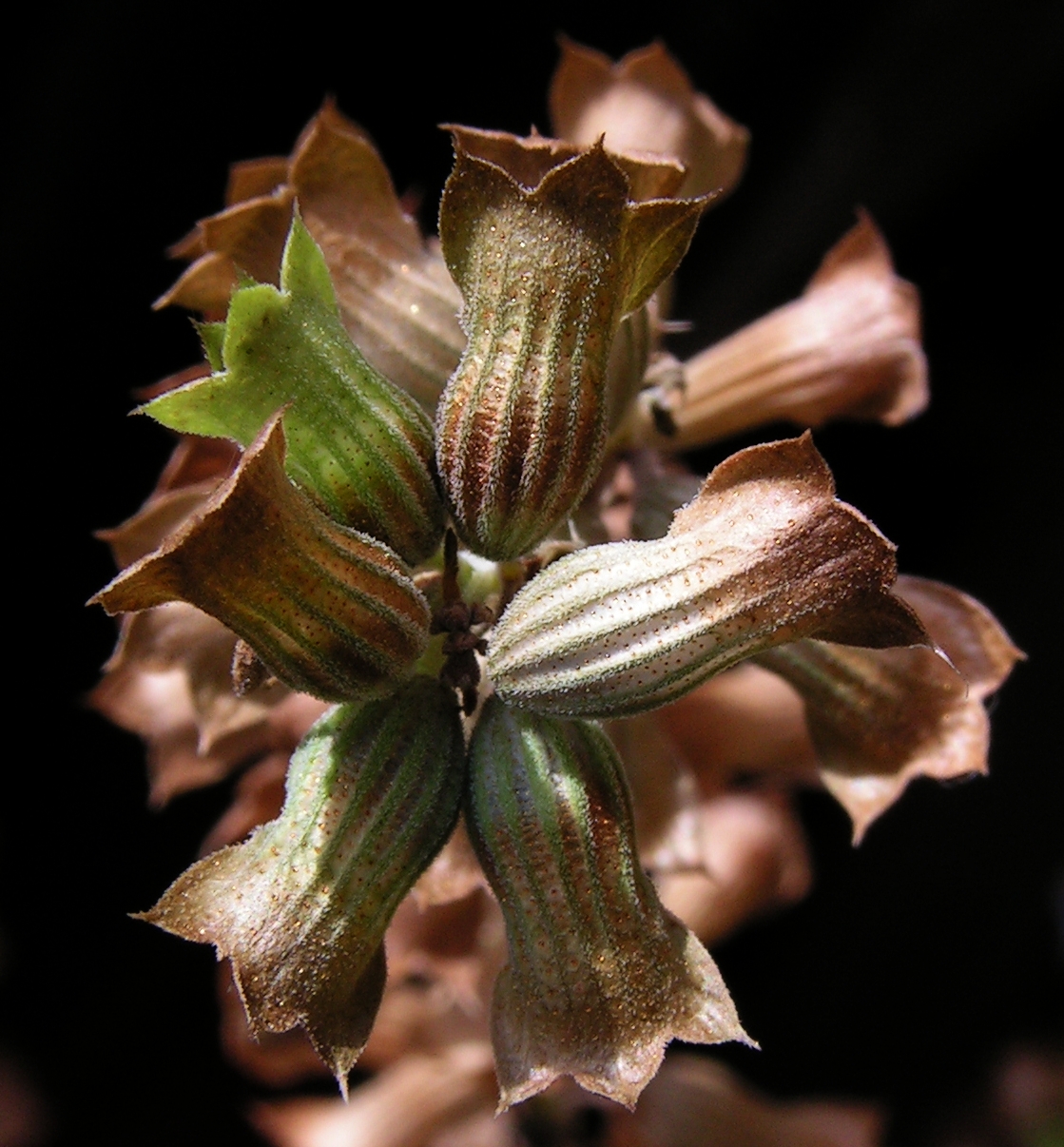| Dragonhead Quick Facts | |
|---|---|
| Name: | Dragonhead |
| Scientific Name: | Dracocephalum moldavica |
| Origin | Temperate climate of Central Asia; in China, Russia, Tajikistan; and Turkmenistan |
| Colors | Initially green and turn brown or tan in color as they mature |
| Shapes | Dry schizocarp that consists of four individual mericarps |
| Taste | Unique blend of minty, lemony, and citrusy notes with hints of spice |
| Health benefits | Anti-inflammatory properties, Antioxidant activity, Digestive health, Respiratory support, Antibacterial and antifungal effects, Relaxation and stress reduction Headache relief, Anti-anxiety and stress relief, Anti-allergic effects, Anti-diabetic potential, Neuro-protective properties, Anti-cancer properties, Boost immune system, Cardiovascular health, Anti-aging effects, Analgesic properties, Antispasmodic effects, Mood enhancement, Skin health and wound healing, Menstrual discomfort, General well-being, Enhancing cognitive function, Anti-parasitic properties |
| Name | Dragonhead |
|---|---|
| Scientific Name | Dracocephalum moldavica |
| Native | Temperate climate of Central Asia; in China (Gansu, Hebei, Heilongjiang, Henan, Jilin, Liaoning, Inner Mongolia, Shaanxi, Xinjiang and Shanxi provinces); Russia (eastern and western Siberia); Tajikistan; and Turkmenistan. It has become naturalized in many locales in Eurasia |
| Common Names | Dragonhead, Moldavian blue skullcap, Moldavian balm, Moldavian lemon balm, Moldavian dragonhead, Moldavian mint, Moldavian blue flower, Moldavian lavender, Moldavian wild marjoram, Turkistan balm, Turkistan dragonhead, Turkistan skullcap, Moldavian calamint, Moldavian sage, Moldavian mintweed, Moldavian mountain mint, Moldavian giant hyssop, Moldavian wild lavender, Moldavian false balm, Moldavian Russian dragonhead, Moldavian fragrant skullcap, Moldavian hummingbird mint, Moldavian violet flower, Moldavian lemon mint, Moldavian purple beauty, Moldavian snapdragon, Moldavian hyssop, Moldavian wild sage, Moldavian wild thyme, Moldavian wild oregano, Moldavian wild bergamot, Moldavian wild mint, Moldavian Melissa, Moldavian bee balm, Moldavian catnip, Moldavian meadow sage, Moldavian hermitage mint, Moldavian skullcap, blue balm, Blue dragonhead, Moldavian silver flower, Moldavian wild basil |
| Name in Other Languages | Afrikaans: Drakonkop Albanian: Koka e drakonit moldavik, dragon kokë Amharic: Ye’esat mesariya (የእሳት መሳሪያ), zenido-ch’inik’ilati (ዘንዶ-ጭንቅላት) Arabic: Ra’s altanin almuldafi (رأس التنين المولدافي), Ra’s altanin (رأس التنين), Ras et tannayn (رﺃس التنين) Armenian: Vishap-glukh (վիշապ-գլուխ), Vishapaglukh moldavakan (Վիշապագլուխ մոլդավական) Assamese: Dragonhead (ড্ৰাগনহেড) Azerbaijani: Moldaviya ilanbaşı, əjdaha başı Basque: Sugeburu Belarusian: Zmiejehaloŭnik maldaŭski (Змеегалоўнік малдаўскі) Bengali: Moldavian Dragonhead (মোলডাভীয় ড্রাগনহেড), Draagonhed (ড্রাগনহেড), Ḍrāgana-māthā (ড্রাগন-মাথা) Bosnian: Moldavsko zmajevo glavo Breton: Kefalek ar vrezhoneg, Kazeg-douar Moldavia Bulgarian: Moldavska glava (Молдавска глава), drakonova glava (драконова глава) Burmese: Nagarr u hkaungg (နဂါး ဦး ခေါင်း) Catalan: Cap de drac moldau Chinese: Mó’ěr duō wǎ là jú (摩尔多瓦蜡菊), Lóng tóu (龙头), Xiang qing lan (香青兰) Bodo: Dragonhead (ड्रैगनहेड) Cornish: Penn an dragon Croatian: Moldavski zmajevac, zmaj-glava Czech: Drakovec moldavský, dračí hlava, včelník moldavský Danish: Dragehoved , dragen-head, Moldavisk dragehoved Dogri: Dragonhead (ਡ੍ਰੈਗਨਹੈਡ) Dutch: Moldavische drakenkop, Drakenkop, Turkse drakekop English: Dragonhead, Moldavian balm, Moldavian Dragonhead, Moldavian Dragon-Head Esperanto: Drako-kapo Estonian: Moldaavia lohepea, lohe-pea Faroese: Dreknaheðin Filipino: Ulo ng dragon Finnish: Lohikäärmepää, dragon-head, Tuoksuampiaisyrtti French: Dracocephalum de Moldavie, Tête de dragon, Dracocéphale de Moldavie, Dracocéphale moldavique, Mélisse turque, Tête de dragon de Moldavie Galician: Cabeza de dragón moldava Garhwali: Dragonhead (ड्रैगनहेड) Georgian: Drakonis tavi (დრაკონის თავი) German: Moldawischer Drachenkopf, Drachenkopf, Moldawische Melisse, Türkischer Drachenkopf, Bastardmelisse, Türkische Melisse Greek: Drakókefalo tis Moldavías (Δρακόκεφαλο της Μολδαβίας), Kefáli drákou (Κεφάλι δράκου), Drakókefalo (Δρακόκεφαλο), Kefáli tou drákou (Κεφάλι του δράκου), Moldau-Drachenkopf, Moldavischer Drachenkopf Gujarati: Ḍrēgana vaḍā (ડ્રેગન વડા), Dragonhead (ડ્રેગનહેડ) Hausa: Kuma na drago, dragon-kai Hebrew: ראש דרקון Hindi: Moldavian Dragonhead (मोल्डावियन ड्रैगनहेड), Dreiganhed (ड्रैगनहेड), ajagar sir (अजगर सिर) Hungarian: Sárkányfej, Moldvai sárkányfű Icelandic: Drekihöfuð Igbo: Ulo ọkụ Indonesian: Dragonhead Moldova, Kepala naga Italian: Dragonhead moldavo, Testa di drago, Capo di drago, Melissa costantinopolitana, Melissa di Moldavia, Melissa turca Irish: Ceann draighean Japanese: Morudavika doragonheddo (モルダヴィカドラゴンヘッド), Doragonheddo (ドラゴンヘッド), Doragonzu heddo (ドラゴンズヘッド), Dorakokefarumu morudavika (ドラコケファルム・ モルダヴィカ), Dorakokefarumu morudabikumu (ドラコケファルム・モルダビクム), Hozaki musharindou (ホザキムシャリンドウ) Javanese: Sirah naga Kannada: Ḍryāgan-heḍ (ಡ್ರ್ಯಾಗನ್-ಹೆಡ್), Dragonhead (ಡ್ರಾಗನ್ಹೆಡ್) Karbi: Dragonhead (ড্রাগনহেড) Kashmiri: Dragonhead (ڈریگنہیڈ) Kazakh: Aydahar-bas (айдаһар-бас) Khasi: Dragonhead (ଡ୍ରାଗନ୍ହେଡ୍) Kokborok: Dragonhead (ড্রাগনহেড) Konkani: Dragonhead (ड्रॅगनहेड) Korean: Moldabia deulaegonhedeu (몰다비아 드래곤헤드), Yong meori (용머리), yong-ui meoli (용의 머리) Kurdish: Dragon-serê Lao: Mangkon hua (ມັງກອນ – ຫົວ) Latin: Caput draconis Latvian: Moldāvijas pūķa galva, pūķa galva Lepcha: Dragonhead (ഡ്രാഗൺഹെഡ്) Lithuanian: Moldavijos drakono galva, drakono galva, Darželinė žiomenė Macedonian: Moldavska glava (Молдавска глава), zmej-glava (змеј-глава) Maithili: Dragonhead (ड्रैगनहेड) Malagasy: Dragona-loha Malay: Kepala naga Malayalam: Drāgaṇ-heḍ (ഡ്രാഗൺ-ഹെഡ്) Maltese: Ras id-Dragun, ras-dragun Manipuri: Dragonhead (ড্রাগনহেড) Marathi: Ḍrĕgana-ḍōkē (ड्रॅगन-डोके), Dragonhead (ड्रॅगनहेड) Mizo: Dragonhead (ဒရုဗမာန်ဟေတ်) Mongolian: Luu-tolgoi (луу-толгой) Nagamese: Dragonhead (ড্রাগনহেড) Ndebele: Indlulamithi yendlovu Nepali: Ḍryāgana-ṭāukō (ड्र्यागन-टाउको), Dragonhead (ड्र्यागनहेड) Norwegian: Dragehode, Tyrkiadragehode, Tyrkiadrakehovud Odia: Dragonhead (ଡ୍ରାଗନ୍ହେଡ୍) Pashto: د ښامار س Persian: اژدها, بادرشبو Polish: Smocza głowa, Głowa smoka, Pszczelnik mołdawski Portuguese: Cabeça de dragão moldavo, Cabeça de dragão Punjabi: Ajagara-sira (ਅਜਗਰ-ਸਿਰ), Dragonhead (ਡ੍ਰੈਗਨਹੈਡ) Romanian: Cap de balaur moldav, dragon-cap, mătăciune, mătăciune-moldovenească Russian: Moldavskiy drakonchik (Молдавский дракончик), Drakoniy golovok (Драконий головок), drakona holova (дракона голова), Zmeegolovnik moldavskij (Змееголовник молдавский) Santali: Dragonhead (ᱡᱟᱢᱤᱞᱟᱡᱤᱱᱩ) Scottish Gaelic: Ceann nathair Serbian: Moldavska glavaca (Молдавска главаца), zmaj-glava (змај-глава), Turkowski pčólnik Sesotho: Morena ea mohloka Setswana: Ntlhatsi ya naga Shona: Mhuka dzedenga Sindhi: Dragonhead (ڊريگن هيڊ) Sinhala: Makarā-hisa (මකරා-හිස) Slovak: Drakovka moldavská, včelník moldavský Slovenian: Moldavijska zmajeva glava, zmajeva glava Spanish: Cabeza de dragon Sundanese: Sirahna naga Swahili: Kichwa cha joka Swazi: Libheshu lebomvu Swedish: Drakfot, dragon-huvud, Turkisk drakblomma Tajik: Aƶdaho-sari (аждаҳо-сари) Tamil: Mōlṭaviya ṭirākaṇheṭ (மோல்டவிய டிராகன்ஹெட்), Draaghanhed (டிராகன்ஹெட்), Ṭirākaṉ-tala (டிராகன்-தலை) Telugu: Ḍrāgan tala (డ్రాగన్ తల), Dragonhead (డ్రాగన్హెడ్) Thai: Drākǒn hĕdmǒldāwīa (ดราก้อนเฮดมอลดาเวีย), Hua mangkon (หัวมังกร), Mạngkr h̄ạw (มังกรหัว) Tripuri: Dragonhead (ড্রাগনহেড) Turkish: Moldavya ejder başı, Ejderbaşı, Ejderha kafası, Ajdar başı Ukrainian: Drakonyacha holova (Драконяча голова), zmiyeholovnyk moldavsʹkyy (змієголовник молдавський) Upper Sorbian: Turkowski pčólnik Urdu: Dragonhead (ڈریگن ہیڈ) Uzbek: Ajdaho boshi Vietnamese: Đầu rồng Moldavian, Đầu rồng Welsh: Pen y ddraig Xhosa: Iqanda lempuphu Yoruba: Ori ejo Zulu: Inkhumbuluko yendlovu, udrako-inhloko |
| Plant Growth Habit | Annual, flowering, herbaceous, bushy-looking, aromatic plant |
| Growing Climates | Dry hills, stony riverbanks and valleys at elevations |
| Soil | Prefers well-draining soil with a slightly acidic to neutral pH level, ranging from 6.0 to 7.0. It can tolerate a variety of soil types, including loam, sandy soil, or clay soil, as long as it is well-draining. Amending heavy clay soils with organic matter can help improve drainage |
| Plant Size | About 1 to 2 feet (30 to 60 centimeters) tall and around 1 to 2 feet (30 to 60 centimeters) wide. However, in optimal growing conditions, they can grow up to 3 feet (90 centimeters) in height |
| Root | Roots are fibrous and generally consist of a primary taproot from which smaller lateral roots branch out. These roots are typically thin and delicate |
| Stem | Stems are typically square-shaped and are sturdy and provide structural support for the plant |
| Bark | It does not possess traditional bark like woody plants. Outermost layer of the stem is composed of a single layer of cells that provide protection to the underlying tissues |
| Leaf | Lance-shaped or ovate, with a serrated or toothed margin. They grow in an opposite arrangement along the stems and are typically medium to dark green in color. The leaves have a textured surface and emit a pleasant aroma when crushed or brushed against |
| Flowering season | Extend from June to August or even into September |
| Flower | Flowers are tubular with a two-lipped structure, characteristic of the mint family. The flower spikes are densely packed with individual flowers, and they can vary in color, including shades of purple, lavender, white, or blue, depending on the variety. |
| Fruit Shape & Size | Dry schizocarp that consists of four individual mericarps. Each mericarp is a small, dry, and seed-containing unit that forms a distinct segment of the fruit |
| Fruit Color | Initially green and turn brown or tan in color as they mature |
| Seed | Small, rounded or oval-shaped, typically measuring around 1 to 2 millimeters (0.04 to 0.08 inches) in diameter |
| Flavor/Aroma | Sweet, Minty, herbal scent with a hint of lemon or citrus zest |
| Taste | Unique blend of minty, lemony, and citrusy notes with hints of spice |
| Plant Parts Used | Leaves, flower, young shoot and seeds |
| Propagation | By seed, division, stem cutting and self-seeding |
| Lifespan | Approximately 3 to 5 years |
| Varieties |
|
| Major Nutrition |
|
| Health benefits |
|
| Other Facts |
|
Plant Description
Dragonhead is an herbaceous, flowering, bushy-looking, perennial plant with a strong smell that grows tall and bushy. The plant usually gets to be between 1 and 2 feet (30 to 60 cm) tall and 1 to 2 feet (30 to 60 cm) wide. But in the best conditions for growth, they can get up to 3 feet (90 centimeters) tall. It grows into a thick clump of leaves and stems that stand straight up from the base. As the plant grows, its clump of leaves slowly spreads out, giving it a round or slightly mounded shape. The plant grows on dry hills, rocky riverbanks, and in high valleys. The plant does best in dirt that drains well and has a pH level between 6.0 and 7.0, which is between slightly acidic and neutral. It can grow in a wide range of soils, including loam, sand, and clay, as long as they drain well. Adding organic matter to heavy clay soils can help them drain better.
Appropriate growing environment for Dragonhead
Dragonhead thrives in specific growing conditions. Here are the appropriate environmental factors for successfully cultivating Dragonhead:
- Climate: Dragonhead likes conditions that are not too hot or too cold. It grows best in places where the daytime temperature is between 65 and 75°F (18 and 24°C) and the nighttime temperature are a bit cooler. It can handle both cool and warm summers, but it might not do well in very hot weather.
- Sunlight: Dragonhead needs a lot of sun to grow well. It should be grown in a spot that gets at least 6 to 8 hours of direct sunshine per day. If there isn’t enough sunshine, plants may grow slowly and have fewer flowers.
- Soil: Dragonhead grows best in dirt that drains well and has a pH level between 6.0 and 7.0, which is slightly acidic to neutral. It can grow in a wide range of soils, including loam, sand, and clay, as long as they drain well. Adding organic matter to heavy clay soils can help them drain better.
- Moisture: Dragonhead likes soil that drains well, but it also needs constant moisture. It’s important to keep the soil fairly moist, but not so wet that it can’t drain. Don’t water too much, because too much water can cause root rot. Getting enough water is especially important when it is hot and dry.
- Watering: Water Dragonhead plants often, especially when the weather is dry, to keep the soil wet. But be careful not to let the dirt get too wet. Between watering, let the top inch (2.5 cm) of dirt dry out a little.
- Fertilization: Dragonhead is an easy-to-care-for plant that doesn’t need a lot of fertilizer. But the nutrients can be added by mixing waste or a well-balanced organic fertilizer into the soil before planting. Don’t use too much nitrogen fertilizer because it can make the plants grow lots of leaves instead of flowers.
- Air Circulation: Good air flow is good for Dragonhead plants because it helps keep them healthy and keeps diseases away. Don’t overcrowd your plants by leaving enough space between them to let air flow.
- Pruning: Dragonhead plants can keep their shape and health by being pruned regularly. After the flowers die, cut back the stems to support new growth and stop the plant from sending out its own seeds. This can also make the flowers last longer and keep the plant looking neater and more compact.
Roots
Dragonhead has flexible roots that usually start with a main taproot from which smaller side roots grow. Most of the time, these roots are thin and fragile. Roots usually grow straight down into the ground, reaching different depths based on how the soil is. The taproot acts as the plant’s main anchor and gives it structure. They can go into the ground anywhere from a few inches to a few feet.
From the main taproot, roots grow out in different directions horizontally. These side roots are smaller than the main roots and are spread out in the top layers of dirt. They are very important for getting water, food, and minerals from the dirt. The roots have tiny root hairs all over them. These root hairs are long, thin protrusions that cover more of the root’s surface. They are in charge of getting water and food from the dirt. The root cap is a protective structure at the end of the main taproot. The root cap is made up of special cells that help the plant move through the dirt and protect the root’s growing tip, which is very delicate.
Dragonhead roots can grow in a few different types of soil, but they do best in soils that drain well and keep enough wetness. Too much water in the earth or too much compaction can stop roots from growing and cause root rot. The roots’ main job is to hold the plant down in the dirt and give it stability and support. They also take in water, minerals, and nutrients from the dirt, which are important for the plant’s growth and development.
Stem
The stem is upright, which means it grows straight up from the ground. It acts as the main support for the plant and connects the different parts of the plant. The stem is herbaceous, which means it is not hard and doesn’t have any new growth on top of it. It stays green and bendable for the whole plant’s life. The stem spreads out, and side branches come out of the main stem. These branches add to the plant’s general size and help give it a bushy look.
Most stems are smooth and have a thin layer of hairs called trichomes. These trichomes can vary in how dense they are and add to the general texture of the plant. Internodes are the separate parts that make up the stem. Internodes are the places between two nodes. They help determine how long and far apart the plant is as a whole. Nodes are places on a plant where leaves, flowers, or branches grow out. Dragonhead’s stem usually has large nodes that serve as connection points for different parts of the plant. At the very tip of the stem, there is a bud with growing points. These growth points make new leaves, stems, and flowers, so the plant can keep growing and changing. In some cases, the roots of Dragonhead plants can store carbohydrates and other nutrients to help the plant survive when it is stressed or sleeping.
Bark
Since the Dragonhead plant is a grass plant, it does not have bark like woody plants. The roots of most herbaceous plants are covered by a different type of tissue called the epidermis. The skin is the part of the stem that is on the outside. It is made up of a single layer of cells that guard the tissues beneath. The epidermis may have a waxy cuticle layer on its surface, which helps to reduce water loss through perspiration and guards against environmental stresses. Trichomes, which look like tiny hairs, may be on the top of the stem. Trichomes can do many things, like keep water from escaping, protect against herbivores, and reflect too much sunshine.
The surface of the stem can be different colors and textures based on the cultivar or the weather. Because it has trichomes, it may look green, smooth, and a little hairy. Sometimes, the stems of Dragonheads will grow small, raised bumps called lenticels. Lenticels allow gas to move between the cells inside the body and the air outside.
Leaves
Most dragonhead leaves are either lance-shaped or egg-shaped. Lanceolate leaves are long and thin and get wider as they get closer to the tip, while ovate leaves are wide and round at the base and get narrower as they get closer to the tip. Along the stem, the leaves are grouped in pairs, or in a whorl. Leaves that are opposite each other are right next to each other. Leaves that are whorled form a loop around the stem at each node. Usually, the edge or border of a leaf is cut or toothed. The size and sharpness of the serrations can change, which makes the leaf look a little bit jagged.
Dragonhead leaves have pinnate veining, which means that the veins start in the middle of the leaf and branch out to the edges. The veins support the plant, carry water and nutrients, and spread the sugars made by photosynthesis. The surface of a leaf can be smooth or rough. It is usually smooth or slightly rough to the touch and can look matte or shiny, based on whether it has a waxy coating or not. Most leaves are bright green, which shows that they have a good amount of chlorophyll. But the color of a leaf can change a little based on its environment. Some leaves can be darker or lighter shades of green.
The size of leaves can change, but most mature leaves are between 0.8 and 2 inches (0.2 to 0.5 cm) long. The size of younger leaves may be smaller. Petioles, which are thin stalks that connect the leaf blade to the stem, hold the leaves to the stem. The length of the petioles can change, which changes how the leaves look and where they are on the plant.
Flowers
The flowers on a dragonhead are grouped in dense spikes or racemes at the end. A spike is a long cluster of flowers that are directly connected to the stem. A raceme is a similar cluster, but each flower is attached to the stem by a short stalk called a pedicle. The flowers are tube-shaped and have two distinct lips, one on top and one on the bottom. Most people’s upper lips are arched or hooded, while their lower lips are generally bigger and wider. Flowers are usually about 2 to 3 centimeters (0.8 to 1.2 inches) long, which is not very big. The size can be a little bit different based on the cultivar and the weather.
Flowers can be any color, but most of the time they are bright shades of purple, pink, or lavender. Some cultivars may also have flowers that are white or blue. Different genes and external factors can affect how bright and what color the color is. The five petals of a flower are joined together to make a tube shape. The petals are set up in two separate lips, with two petals making up the upper lip and three petals making up the lower lip. There are four stamens inside the flower. They are all in pairs. The pollen-making structures, called anthers, are held up by thin threads on the stamens. The pistil, which is the female reproductive center, is in the middle of the flower. There is an ovary, a style, and a stigma on the pistil. The ovules are in the ovary, and once they are fertilized, the ovary turns into a fruit. Some types of Dragonhead may have flowers that have a nice, fragrant smell. The smell can be light or strong, and people often say it smells sweet or medicinal. Pollinators like bees, butterflies, and hummingbirds are drawn to flowers.
Fruit
The fruit is a schizocarp, which is dry. When it’s ready, a schizocarp, which is a type of dry fruit, splits into mericarps, which are single-seeded pieces. The schizocarp is made up of four separate mesocarps. Each mericarp is a small, dry unit with a seed inside that makes up a separate part of the fruit. Most of the time, the mericarps are round, oval, or oblong, and they are about 3 to 4 millimeters (0.12 to 0.16 inches) long. The shape and size can be a little different based on the cultivar and how it grows.
When Dragonhead mericarps are fully grown, they are often brown or tan in color. The change in color shows that they are ready to go. Depending on the breed, the surface of the mericarps can be smooth or have a little texture. The surface can be fairly smooth or a little bit wrinkled or ridged.
Seeds
The seed coat is the outside layer that protects the seed. The seed coat is made of a tough, long-lasting material that helps protect the egg as it grows inside. Most seeds are small and round or oval in shape. They come in different sizes, but usually have a width of 1 to 2 millimeters (0.04 to 0.08 inches). The size may be different based on the type of plant and how it grows. Most seeds are brown or very dark brown. The color can be a little different based on how old the plant is and what its genes are like.
In the Dragonhead seed, there is an embryo inside the seed coat. The baby is the plant when it is still young and just starting to grow. It is made up of the young root (radicle), the young shoot (plumule), and the first leaves. Some Dragonhead seeds may have a small amount of endosperm. Endosperm is a nutrient-rich tissue that feeds the embryo as it grows. During the process of germination, the egg may eat some of the endosperm. Depending on how they are stored and how good they are, dragonhead seeds can live for a certain amount of time. The seeds can last longer if they are stored in a cool, dry, and dark place.
History
Dragonhead is thought to have come from Central Asia, which includes parts of Kazakhstan, Uzbekistan, and Turkmenistan today. It is thought that old civilizations in this area grew it and used it for many different things. During the middle Ages, dragonhead was first brought to Europe. It’s possible that traders and explorers who went along the Silk Road, a major trade route between Asia and Europe, brought it back with them. Both as a decoration and as a medicine, the plant became very famous very quickly. By the 17th century, Dragonhead was being grown all over Europe, especially in England, France, and Germany. People liked it because it was easy to grow and because its flowers were bright and smelled nice.
Dragonhead has stayed famous for hundreds of years and is still grown all over the world today. It is liked by farmers because of its pretty flowers, unique scent, and ability to bring in pollinators. In recent years, people have become more interested in Dragonhead because it might be good for your health and because it is good for pollinators. Researchers are looking into its phytochemical makeup, bioactive compounds, and possible uses in many different areas.
Varieties of Dragonhead
There are several varieties of Dragonhead that exhibit variations in characteristics such as flower color, growth habit, and leaf morphology. Here are some notable varieties:
- Moldavian Dragonhead: This type of Dragonhead is the most popular and easy to find. It grows in a tight, thick shape and has bright spikes of purple or lavender flowers. It is known for having fragrant leaves and is often grown as a decoration.
- White Dragonhead: The flowers on this type are white instead of the usual purple or lavender. It gives gardens and fields a unique and different look. When put together with other flowering plants, the white flowers really stand out.
- Blue Dragonhead: The blue flowers of this type make it stand out. It gives outdoor displays a cool color and can be the center of attention. The blue flowers make the area look cool and peaceful.
- Rose Queen: This cultivar features beautiful deep pink or rosy flowers. The coloration of the flowers gives it an elegant and romantic appearance. ‘Rose Queen’ Dragonhead is often sought after for its decorative value in flower arrangements and bouquets.
- Variegata: This type has leaves that are a mix of green and creamy white. The plant’s different colors and patterns make it interesting to look at and make it a good choice for yard borders and pots.
- Giant Dragonhead: As the name says, this variety is known for having bigger flowers and bigger leaves. It stands out in gardens, and when placed in groups or as a background for other flowering plants, it can be especially beautiful.
- Golden Dragonhead: This unique type has yellow flowers that add a burst of bright, sunny color. The golden colors make it a cheerful addition to flowerbeds or planters.
- Compacta: This variety is small enough to grow in small areas or pots. It still has the characteristic purple flowers and fragrant leaves, but it grows more slowly.
- Alba: The flowers of ‘Alba’ are pure white, giving fields a clean and peaceful look. It has beautiful white flowers that stand out against the green leaves.
- Purple Majesty: This variety has velvety flowers that are a deep purple color. They give garden displays a sense of wealth and sophistication.
- Silver Dragon: The silver-gray leaves of this striking type make a unique and eye-catching contrast. The plant looks more attractive because its leaves have a golden sheen.
- Cobalt Dreams: Cobalt Dreams has flowers that are very bright blue and make a strong statement in the yard. The deep blue color gives flower designs a sense of drama and depth.
Health benefits of Dragonhead plant
Dragonhead is a plant that has been traditionally used in herbal medicine for various health benefits. While it is important to note that scientific research on the specific health effects of dragonhead is limited, here are some of the potential benefits associated with this plant:
1. Anti-inflammatory properties
There are chemicals in dragonhead that may help reduce inflammation. Inflammation is a normal reaction of the body, but if it lasts too long, it can lead to a number of diseases. Dragonhead’s anti-inflammatory properties may help reduce inflammation, which could help diseases like arthritis, heart disease, and some kinds of cancer.
2. Antioxidant activity
Flavonoids and phenolic acids, which are found in dragonhead, are thought to give it antioxidant qualities. Antioxidants help get rid of dangerous free radicals in the body. This lowers oxidative stress and the chance that cells will be damaged. This could help improve your general health and protect you from long-term illnesses like heart disease, cancer, and neurodegenerative diseases.
3. Digestive health
Dragonhead has been used for a long time to help the digestive system. It might speed up processing, make you hungrier, and ease stomach pains like bloating and gas. Compounds in the plant might also have antispasmodic qualities, which could help relax the muscles in the digestive system and ease digestive problems.
4. Respiratory support
Dragonhead has been used for a long time to treat lung problems and keep the lungs healthy. It might help loosen and get rid of phlegm by acting as an expectorant. This could make it useful for coughs, asthma, and congestion.
5. Antibacterial and antifungal effects
Some studies show that some bacteria and fungi can’t live in the presence of dragonhead extracts. This could be why it has been used for centuries as a natural cure for diseases. But more study is needed to learn more about the specific mechanisms and possible uses in this area.
6. Relaxation and stress reduction
Dragonhead’s scent, which is soothing and calming, has been linked to helping people rest and feel less stressed. It might help people calm down, feel less anxious, and feel better generally. Aromatherapy is one way that the smell of the plant can be used to help people feel better.
7. Headache relief
Dragonhead has been used for centuries because it is thought to have pain-relieving qualities and help with headaches and migraines. But there isn’t much scientific proof to support this, and other ways to treat headaches should also be thought about.
8. Anti-anxiety and stress relief
Dragonhead is thought to have calming effects that could help ease nervousness and make it easier to relax. When you breathe in the smell of the plant, it may calm your mind and nervous system, which could help you feel less stressed.
9. Anti-allergic effects
Some tests show that Dragonhead may be good for people with allergies. It might help control the immune response and stop the body from releasing histamine, which is what causes allergic symptoms. This could make Dragonhead good for people with allergies or breathing problems that are made worse by allergens.
10. Anti-diabetic potential
Initial studies have shown that Dragonhead products may help people with diabetes. They may help control blood sugar by making the body more sensitive to insulin and better at using glucose. But more research is needed to learn more about how it works and how it could be used to help manage diabetes.
11. Neuro-protective properties
Studies have shown that some of the chemicals in Dragonhead may help protect nerve cells. These compounds may help protect brain cells from damage caused by oxidative stress and inflammation. This could lower the chance of neurodegenerative diseases and improve cognitive health.
12. Anti-cancer properties
Some study suggests that Dragonhead extracts may help fight cancer, possibly because they are anti-inflammatory and have antioxidant properties. These qualities may help stop cancer cells from growing and lower the risk of some kinds of cancer. But more research, like clinical trials, is needed to fully look into this possibility.
13. Boosting the immune system
Dragonhead has been used for a long time because it might help the defense system. It might help the immune system work well and help the body’s natural defenses against diseases and illnesses.
14. Cardiovascular health
Dragonhead may be good for the health of the heart and blood vessels. It has been said to have hypotensive (lowers blood pressure) and vasorelaxant (relaxes blood vessels) properties, which could help keep blood pressure at a healthy level and support overall cardiovascular performance.
15. Anti-aging effects
Dragonhead has anti-oxidant traits that could help fight oxidative stress, which is a major cause of ageing. Dragonhead has antioxidants that can help neutralize free radicals and protect cells from damage. This could help the face stay young and healthy.
16. Analgesic properties
Dragonhead has long been used as a natural way to ease pain. It might have some mild pain-relieving qualities that could help with things like headaches or sore muscles. But it’s important to remember that serious or long-term pain should be treated by a doctor or nurse.
17. Antispasmodic effects
Dragonhead may help ease muscle spasms and cramps because it may have antispasmodic properties. It might help with things like menstrual cramps, digestive twitches, and tight muscles.
18. Mood enhancement
Dragonhead is known for having a nice smell that people often compare to a mix of lemon and mint. In aromatherapy, the smell of Dragonhead is thought to make people feel better, help them relax, and lift their spirits.
19. Skin health and wound healing
Dragonhead has been used topically for a long time to help wounds heal and relieve skin problems. It might kill bacteria, which could help avoid infections and speed up the healing of small cuts, burns, and abrasions.
20. Menstrual discomfort
Dragonhead has been used in some countries to ease the pain and cramping of menstruation. It may help relax the uterine muscles and ease the pain of menstruation because it has antispasmodic qualities.
21. General well-being
Dragonhead has been used as a general tonic for total health in traditional herbal medicine. It is thought to keep the body in balance and give it more energy.
22. Enhancing cognitive function
Some old ways of doing things say that Dragonhead may help improve your mind. It has been used to clear the mind, improve focus, and help the brain work better generally.
23. Anti-parasitic properties
Dragonhead has long been used as a natural treatment for diseases caused by parasites. Its chemicals are thought to have anti-parasitic qualities that could help get rid of parasites in the gut.
Culinary uses of Dragonhead
Dragonhead has a rich history of culinary uses and is valued for its unique flavor and aromatic qualities. Here are some detailed culinary uses of Dragonhead:
- Culinary Herb: Dragonhead is often used as a fresh or dried flower in cooking. Dragonhead’s leaves taste strongly of mint and lemon, with hints of citrus and spice. They can be used as fresh herbs to give different recipes a unique flavor.
- Herbal Teas and Infusions: Dragonhead’s leaves and flowers can be used to make plant teas and other drinks that taste good. The plant’s pleasant smell makes it a great addition to both hot and cold drinks. You can also mix the leaves with other herbs and spices to make your own tea blends.
- Flavoring Salads and Dressings: When the leaves of a dragonhead are finely chopped and added to salads, they give them a cool, minty taste. They can also be used to add flavor to homemade salad sauces. This gives traditional recipes a unique twist.
- Seasoning for Soups and Stews: Dragonhead leaves can be added to soups, stews, and broths to make them taste better. Their minty and citrusy notes can add depth and complexity to the general taste of a dish.
- Garnish for Savory Dishes: Dragonhead sprigs can be used to decorate savory meals like roasted vegetables, grilled meats, or fish. The bright green leaves and small, delicate flowers make the plant look nice and give it a pleasant taste.
- Flavoring Desserts and Baked Goods: The leaves and flowers of the dragonhead plant can be used to add flavor to sweets and baked goods. They can be added to syrups, custards, ice creams, and cakes and sweets as a topping. The unique flavor profile gives sweets a twist that makes them more interesting.
- Herbal Liqueurs and Cocktails: Dragonhead can be added to homemade liqueurs, like herbal liqueurs or plant spirits, to add flavor. It can also be used as a garnish or mixed into drinks to give them a fresh, fragrant touch.
- Herbal Butter and Oils: The leaves of dragonhead can be finely chopped and mixed into melted butter or oils. This butter or oil with herbs in it can be used to add flavor to grilled veggies, pasta dishes, or even bread.
- Fresh Herb Accent: Dragonhead’s fresh leaves can be chopped or torn into small pieces and used as an accent in many recipes. Their fragrant taste makes salads, soups, stews, sauces, and other foods taste brighter and richer.
- Flavorful Infusions: The leaves and flowers of dragonhead can be steeped in hot water to make plant infusions that taste good. The final mixture can be drunk as herbal tea on its own or used as a base for more complicated drinks.
- Natural Flavor Substitute: Dragonhead can be used in place of other herbs and spices in recipes that call for them. It has a unique flavor that can be similar to that of mint or lemon balm. This gives meals a different twist.
- Herbal Syrups and Cordials: By putting its leaves and flowers in simple syrup or alcohol, dragonhead can be used to make plant syrups and cordials. These syrups and cordials can be used to add a natural and fragrant taste to drinks, cakes, and cocktails.
- Infused Vinegars: Dragonhead can be used to add herbs to vinegars, which can then be used in salad dressings, marinades, and stews. The process of infusing gives the vinegar Dragonhead’s special flavor, which makes dishes more interesting.
- Herbal Butter for Grilled Meats: Finely chopped dragonhead leaves can be mixed with melted butter to make a tasty herb-infused butter. This herb butter can be used to top grilled foods for a burst of flavor and extra moisture.
- Aromatherapy in the Kitchen: Dragonhead’s smell can be a pleasant experience in the kitchen. Its fresh smell can make people feel better and create a nice atmosphere while cooking or making food.
Different uses of Dragonhead
Dragonhead has various uses beyond its culinary applications. Here are different uses of Dragonhead in detail:
- Herbal Remedies: In ancient herbal medicine, the leaves and flowers of the Dragonhead plant were used to make infusions or decoctions. They can be made to treat certain health problems or as a general health aid. Most of the time, these mixtures are used as drinks or put on the skin for different reasons.
- Ornamental Plant: Dragonhead is famous because it has pretty flowers that look good in gardens, flower beds, and pots. Its purple, lavender, white, or blue flowers on tall spikes add color and beauty to environments. It can be used as a decorative plant on its own or as part of a mix of other flowers.
- Pollinator Plant: Dragonhead’s flowers have a lot of juice, which is why bees, butterflies, and hummingbirds like to visit them. By planting Dragonhead, you can help the pollinators in your area and make your yard or landscape more diverse.
- Cut Flower: Dragonhead has flowers that last for a long time and can be used to make flower designs. Their bright colors and interesting shapes make them a great addition to bouquets, centerpieces, and other flower arrangements.
- Aromatherapy: Dragonhead can be used in massage because it has a pleasant smell. The plant’s essential oil can be used in diffusers or added to bath items to make an atmosphere that is both relaxing and uplifting.
- Companion Planting: When used as a partner plant, dragonhead is known to help other plants around it. It can bring in good bugs, keep away bad bugs, and make neighboring plants healthier and stronger.
- Educational Purposes: Dragonhead can be used in schools to teach about the biology of plants, how pollination works, and how important it is for ecosystems to have natural plants. Because of how it looks and how it grows, it is a good plant for educational gardening or botany classes.
- Traditional Crafts: The flowers and leaves of dragonheads can be dried and used in a number of traditional crafts. You can put them in potpourri, sachets, or plant wreaths to give your home a natural and fragrant touch.
- Natural Dye: Dragonhead’s flowers can be used to make natural dyes. They can give fabrics, yarns, or other things soft shades of purple, lavender, or blue. This way of dying with natural materials is better for the environment than using synthetic colors.
- Herbal Baths: Leaves and flowers of dragonhead can be added to warm bathwater to make a relaxing plant bath. The smell of the plant can help you relax, relieve stress, and have a soothing bath.
- Potent Potpourri Ingredient: Dragonhead flowers and leaves can be added to potpourri to make it smell better and look better. Their unique smell and bright colors make for a lovely potpourri mix that can be used to scent rooms or closets.
- Insect Repellent: Some people say that Dragonhead is good at keeping bugs away. People think that planting it or putting it near outdoor seating areas or using it as a natural ingredient in homemade bug repellents will help keep mosquitoes and flies away.
- Floral Infused Vinegars and Oils: Dragonhead flowers can be used to add a soft floral flavor and smell to vinegars and oils. These vinegars and oils can be used to cook, make salad dressings and marinades, or add a gourmet touch to a variety of meals.
- Herbal Poultice: Dragonhead leaves, whether they are fresh or dried, can be used to make a plant poultice. When put on the skin, the poultice may have anti-inflammatory and cooling qualities that can help soothe minor skin irritations, bug bites, or bruises.
- Edible Garnish: The brightly coloured flowers of Dragonhead can be used to decorate food, desserts, or drinks. They give food a pop of color and a little bit of fun, which improves the way it looks overall.
- Natural Air Freshener: Dragonhead flowers and leaves that have been dried can be used as a natural way to clean the air. Putting them in bowls or sachets and putting them around the house can give off a nice smell and naturally freshen the air.
Side effects of Dragonhead
While Dragonhead is generally considered safe for most people when consumed in moderate amounts, there are a few potential side effects and considerations to keep in mind:
- Allergic Reactions: Some people may be allergic to or sensitive to Dragonhead or other plants in the family Lamiaceae, which also includes mint and other herbs. Allergies can cause rashes, itchiness, swelling, or problems with breathing. If you know you are allergic to plants in this family, you should not eat Dragonhead.
- Drug Interactions: Dragonhead may affect how some medicines work. It has chemicals in it that can affect the enzymes in the liver that break down drugs. Before taking Dragonhead, especially in large amounts or as a concentrated supplement, you should talk to a doctor if you are also taking medicines that are processed by the liver.
- Pregnancy and Breastfeeding: There isn’t much known about how safe Dragonhead is during pregnancy and while nursing. As a safety step, women who are pregnant or who are nursing should avoid taking medicinal or concentrated forms of Dragonhead. Before using Dragonhead, talk to a doctor or nurse if you have any worries.
- Gastrointestinal Upset: If you eat a lot of Dragonhead or use it in a concentrated form, it may upset your stomach or intestines, causing sickness, stomach pain, or diarrhea. Start with small amounts of Dragonhead and watch how your body reacts to figure out how much you can handle.
- Photosensitivity: Some people may be more sensitive to sunshine or UV rays after taking Dragonhead or putting it on their skin. If you find that you are more sensitive to the sun, you should use sunscreen or other sun protection measures.
- Skin Sensitivity: When some people come into close contact with Dragonhead leaves or flowers, their skin may become sensitive or irritated. It is best to be careful when handling the plant and to avoid long-term skin contact if you have any bad responses.
- Hormonal Effects: There are chemicals in dragonhead that may act like estrogen. Even though this is usually not a problem when Dragonhead is used in food, too much or long-term use of concentrated Dragonhead pills may change the way hormones work in the body. Before using concentrated Dragonhead products, you should talk to a doctor if you have conditions or worries that are linked to hormones.
- Blood Pressure Effects: Some people may experience a slight drop in blood pressure when they eat dragonhead. This can be helpful for people with high blood pressure, but it could cause their blood pressure to drop, which could be dangerous for people with low blood pressure. Before taking Dragonhead as a vitamin, it’s best to talk to a doctor if you have problems with your blood pressure or if you already take blood pressure medicine.
- Interference with Iron Absorption: Even though it’s been said before, it’s worth saying again that Dragonhead has chemicals in it that may stop the body from absorbing iron from food. If you don’t get enough iron or take iron pills, it’s best to eat Dragonhead at a different time from iron-rich foods or supplements so that your body can absorb the iron best.
References:
https://www.itis.gov/servlet/SingleRpt/SingleRpt?search_topic=TSN&search_value=32489#null
https://npgsweb.ars-grin.gov/gringlobal/taxon/taxonomydetail?id=14656
https://pfaf.org/user/Plant.aspx?LatinName=Dracocephalum+moldavica
https://gd.eppo.int/taxon/DRAMO
http://www.theplantlist.org/tpl1.1/record/kew-63836
https://indiabiodiversity.org/species/show/244997
http://www.worldfloraonline.org/taxon/wfo-0000945394
https://gobotany.nativeplanttrust.org/species/dracocephalum/moldavica/
https://en.wikipedia.org/wiki/Dracocephalum_moldavica
https://temperate.theferns.info/plant/Dracocephalum+moldavica
https://plants.usda.gov/home/plantProfile?symbol=DRMO


